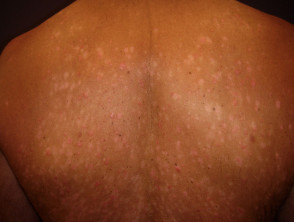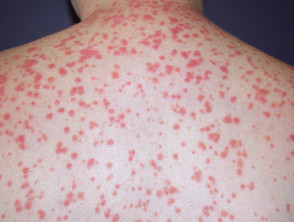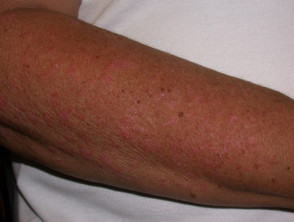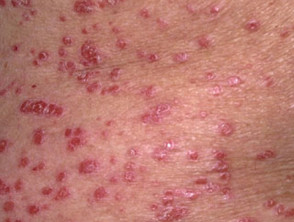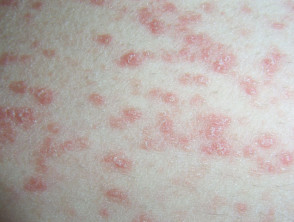What is guttate psoriasis?
Guttate psoriasis is a form of acute psoriasis described as a shower of small, pink-red, scaly ‘raindrops’ that has fallen over the body.
Guttate psoriasis
Who gets guttate psoriasis?
Guttate psoriasis tends to affect children and young adults; it is the second most common form of psoriasis in children after chronic plaque psoriasis. Both sexes and all races can develop guttate psoriasis. It is often the first presentation of psoriasis for an individual, but can also be seen in those with known chronic psoriasis.
What causes guttate psoriasis?
Guttate psoriasis typically develops 1–2 weeks after a streptococcal infection of the upper respiratory tract, particularly tonsillitis, or other sites such as perianal streptococcal dermatitis. Beta-haemolytic streptococci can directly stimulate skin-homing T-cell proliferation in the tonsils.
Guttate psoriasis has been reported to follow SARS-CoV-2 infection (COVID-19) and other viral infections such as coxsackievirus. [see Enteroviral infections]
What are the clinical features of guttate psoriasis?
- Acute onset over days
- Numerous small patches (<1 cm)
- Pink, scaly, thin patches or plaques of psoriasis
- Scale can be subtle in early lesions
- Widespread lesions predominantly over the trunk and limbs
- Lesions on the face, scalp, and ears tend to be faint and short-lived
Guttate psoriasis
See also Guttate psoriasis images
Dermoscopy of guttate psoriasis
- Uniformly distributed red dotted vessels
- Diffuse white-grey scale
- Bright red, dull red, or pink background
These dermoscopy features are diagnostic and are seen in all skin types.
What are the complications of guttate psoriasis?
- Psychosocial effects and impaired quality of life
- Complications of psoriasis eg, metabolic syndrome, non-alcoholic fatty liver disease [see Liver problems and psoriasis]
- Dyspigmentation in skin of colour
How is guttate psoriasis diagnosed?
Guttate psoriasis is a clinical diagnosis, aided by dermoscopy, which can be confirmed on skin biopsy.
Examination and investigations should include a search for streptococcal infection.
Tests may include:
- Swabs for bacteriology
- Blood tests — Anti-streptolysin O titre (ASOT), anti-DNase B titre.
What is the differential diagnosis for guttate psoriasis?
What is the treatment for guttate psoriasis?
- Treatment of an associated active streptococcal infection with antibiotics
- However, antibiotics seldom help the rash of guttate psoriasis
- Narrowband UVB phototherapy
- Emollients
- Tonsillectomy for recurrent episodes
What is the outcome for guttate psoriasis?
Guttate psoriasis often clears within 3-4 months, even without treatment. Patients with proven streptococcal infection triggering the guttate psoriasis have a good prognosis. However, it may recur with another episode of streptococcal infection.
Guttate psoriasis may become persistent and evolve into chronic plaque psoriasis. Approximately 25% of cases of guttate psoriasis develop chronic plaque psoriasis. An even higher rate of chronic psoriasis is seen in patients with guttate lesions persisting for 12 months or more.
